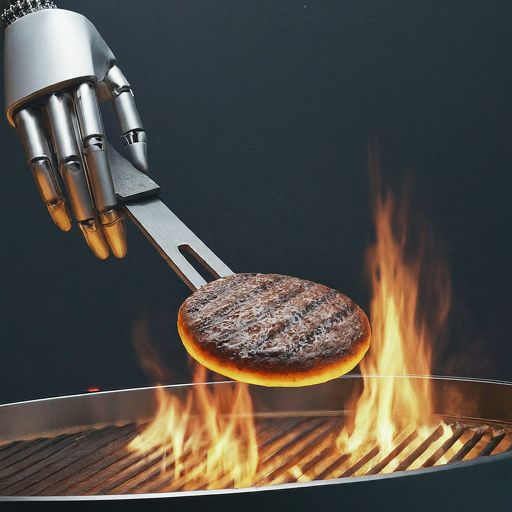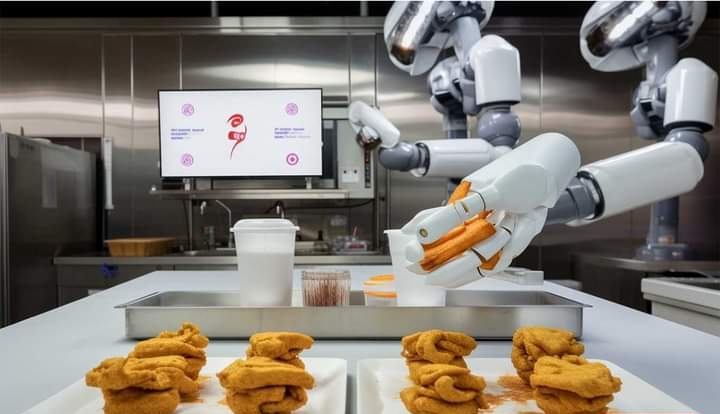Let’s meet Flippy. Flippy is a fry-station specialist. He works at America’s first fast-food hamburger chain ‘White Castle’.
Since 2021, Flippy has been working tirelessly in 10 branches in Chicago.
Flippy works sitting under the protection of a safety shield so he doesn’t burn himself. It can automatically put food in the frying basket. Also can remove food from frying basket. Also can identify foods that are meant for frying. Can put them in the correct basket.
While Flippy safely prepares French fries, White Castle employees can serve customers and perform other restaurant tasks.
You guessed it right, Flippy is an AI-powered robot.

According to the ‘International Federation of Robotics’, more than 5 lakh industrial robots have been installed in the world. Most of which are used in manufacturing.
There is a shortage of skilled workers in industries worldwide. That’s why many companies are now forced to use robots for various tasks, from taking orders online to hotel room service
Deborah Matteliano is the Global Head of Restaurant Services at Amazon Web Services. According to him, restaurants are getting an opportunity to improve the guest experience as robots do all the tedious tasks in the kitchen.
Miso Robotics, the company behind Flippy, pioneered the use of automation in the restaurant industry. The startup is based in California, USA. The company was founded in 2016 with the idea of creating robots to do the boring, dirty and dangerous jobs in restaurant kitchens.
Robots tend coffee stations, deliver ice and drinks, and cook french fries, tortilla chips and other fried foods—even adding condiments.
Miso’s robots can handle the most dangerous tasks in the kitchen. Besides, it goes without saying that these are the dirtiest and tiring jobs.
Miso’s Chief Technology Officer is Chris Kruger. That being said, robots make it possible for restaurants to stay open much longer. Workers also have to do less physical work. The manpower required is also less.
The 2023 report of the US ‘National Restaurant Association’ has seen a massive expansion of the restaurant industry. While other industries struggle to grow sales, the association expects restaurant industry revenue to exceed $997 billion by the end of 2023. Which is 11 percent more than 2022.
Because of this increase, demand for food service workers was expected to exceed pre-pandemic levels. It has increased the recruitment rate. However, there is a shortage of skilled workers. There are currently 87,000 vacancies in the US alone. Apart from this, the rate of employees leaving work is also the highest in the field of food service. According to a survey by the National Restaurant Association, 92 percent of restaurant owners said that rising food prices were the main reason workers quit.
Using robots in restaurants is getting better results, reducing costs. The problem of labor shortage is being solved. Along with this, it is possible to offer consumers a great dining experience.
These robots are managed through the cloud. Miso provides “Robots as a Service” (RaaS). If customers want to avail this service, they will have to pay a monthly fee for the robot, software and other support. As a result, the cost of automation in these restaurants has come down a lot.
As the miso business is constantly growing, the company has to work with the utmost efficiency and speed. Since Miso’s robots are managed through a cloud system, Miso can improve the quality of their products and services whenever the need arises.
Miso can also easily manage a growing fleet of robots with the help of the cloud. This means that they only spend money for necessary reasons, not overspending.
Miso is using the Amazon Web Services Migration Acceleration Program (AWS MAP) for their robot services. Amazon’s tools, training and other resources helped Miso move quickly to the cloud. This has saved them from the high costs of running a data center. By doing so, the company is now able to add new features to their services. Able to design products on their own. Able to focus on serving customers more.
Krueger says Amazon Web Services (AWS) has helped them focus less on infrastructure and focus on products and customers. Miso has greatly increased the capacity for experimentation, dimension and innovation.
These robots by Miso are built with various internet based devices or IOT and sensors. The cloud system that the robots are connected to can process an almost infinite amount of data. These data can be combined and stored. The company collects this data from its robots using Amazon Web Services. Can analyze robot performance. In this way, they can quickly develop robot applications as needed and anticipate customer needs.
With the help of the cloud, Miso Company also develops the necessary software for their robots. Amazon Web Services has a cloud-based simulation service called RoboMaker. Using it, developers can conduct various types of simulations.
Miso runs 50 simulations simultaneously. As a result, they have been able to improve their products very quickly. It also saves a lot of cost.
White Castle recently partnered with Miso. They are going to launch a new version of Flippy in their 100 different outlets.
Flippy-2 can do all the functions of a fry station. And since White Castle also uses Amazon Web Services, they can easily share data with Miso.
Another famous restaurant chain in the US is ‘Chipotle Mexican Grill’. They operate more than 3,000 restaurants in America. Like White Castle, the company approached Miso Robotics 2 years ago to improve kitchen safety, customer focus and the quality of its tortilla chips.
They want to automate the process of frying chips. In every Chipotle restaurant, all the chips are usually cooked in the morning. Because of this, hot tortilla chips were not available for most of the day.
Miso built a robotic Chips Radhuni in less than a year through simulation using Amazon Web Services’ RoboMaker. Its name is ‘Chippy’. With Chippy, Chipotle can make a lot of chips in a short amount of time. It produces very little waste and produces high quality tortilla chips.
Today, restaurants are constantly looking for new ways to improve their efficiency and customer experience. Automation is playing an important role in this.
According to a 2021 report by Lightspeed State of the Global Hospitality, 50 percent of restaurant managers plan to implement some form of automation technology in the next few years.
Miso’s chief technology officer, Chris Krueger, hopes the increasing role of technology will also help increase the efficiency of restaurant workers.
In his words, “Employees are no longer having to fry food, but are now learning how to interact with robotics systems. I can see the day when restaurant workers are trained on Amazon Web Services, creating their own vision of robots. Using this data By doing so they will make robots more advanced.”
Restaurant, robot, automation, Foodservice, Automation, Robots, Flippy, ArtificialIntelligence, RestaurantTechnology, FutureofFood, Jobs, Efficiency, Quality, AI, RobotsAreTakingOver (optional use humorously)





